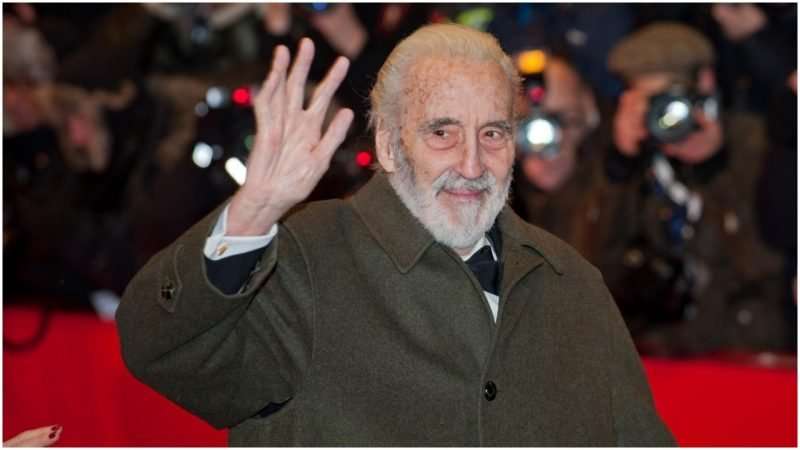Christopher Lee was arguably one of the most memorable actors of the late 20th century and early 21st-century cinema. His career, which began in 1947 and ended with his death in 2015, included 259 film and TV credits. He was most often cast by directors who needed an actor who could flawlessly portray a cunning and mysterious villain: he portrayed Dracula many times, he appeared as the ruthless Francisco Scaramanga in the Bond film The Man with the Golden Gun and the eerie Lord Summerisle in The Wicker Man. Also, fans of the Star Wars franchise remember him as the Sith Lord Count Dooku, and Tolkien lovers praise his portrayal of the evil wizard Saruman in The Lord of the Rings and The Hobbit trilogies.
At one point during the filming of The Lord of the Rings: The Two Towers, the second installment of the acclaimed trilogy, the crew filmed the scene in which Saruman gets stabbed in the back by Grima Wormtongue. Although the scene didn’t end up in the theatrical release, it can be seen in the extended edition of the trilogy. During the filming of the scene, Jackson wanted Lee to scream after being stabbed in the back. However, Lee refused to scream; he told the director that he witnessed many men getting stabbed in the back and none of them ever screamed. According to the late actor, they merely sighed as air escaped their lungs. Peter Jackson listened to his feedback, and the scene was filmed without any screaming.
Many might ask where an esteemed actor such as Christopher Lee could have witnessed the horrors of stabbing and killing. Well, the answer is: World War II. Before he became a celebrated actor, Lee had an extensive military career and fought for the British on several fronts. When the war broke out, he joined the Royal Air Force in hope of becoming a fighter pilot. Unfortunately for him, a medical examination uncovered that his optical nerve was damaged and his superiors concluded that he would never be able to fly.
Lee’s dream of fighting for the Allies in the sky was shattered, but he didn’t give up: He joined the RAF intelligence and became a field agent. He conducted combat missions and was involved in high-risk covert operations in South Africa, Zimbabwe, and Rhodesia before becoming a member of the Long Range Desert Patrol, an organization that eventually became the SAS, the special forces unit of the British army.
As a member of the Patrol, he fought against the Axis forces on the North African Front and was involved in the Allied liberation of Sicily. Therefore, he must have witnessed a fair share of fighting and killing.
After proving to his superiors that he was an extremely capable soldier and an adaptive field agent, he was transferred to Winston Churchill’s elite unit named Special Operations Executive. The unit, which was nicknamed “The Ministry of Ungentlemanly Warfare” by the public of the time, was infamous for conducting espionage and sabotage and organizing assassinations of enemy officials in the Nazi-occupied countries of Europe. Even though World War II has been over for more than 70 years, almost all details on the operations carried out by the SOE remain classified.
After the war, Lee’s bravery during the war was recognized and commended by the governments of England and Poland and then existing Czechoslovakia, and Yugoslavia.
When the war ended, Lee was actually persuaded into going into acting by his cousin Nicolo Carandini, the then Italian ambassador to Britain. In 1946, several weeks after he decided to leave the RAF for good, Lee met his cousin for lunch. During lunch, he told several long stories about his war wounds and the horrors he witnessed: Carandini was so impressed by Lee’s emotional “performance” that he urged him to try and find work as an actor.
Related story from us: J. R. R. Tolkien named the kind and protective hobbit Samwise Gamgee after a pioneering British surgeon
From that point on, more and more directors noticed Lee’s incredibly menacing voice and the passion with which he portrayed all kinds of characters. Peter Jackson was quite lucky to get schooled about the grim art of on-screen dying by a man who spent a lot of time surrounded by actual death.

InsertAlinaLiOnFace on April 10th, 2018 at 11:51 UTC »
Brad Dourif, who played Wormtongue, spoke often with Lee on set thanks to them basically sharing the screen so often, and in one of the documentaries of the EE's, he says that a bunch of the crew were having a competition of throwing a knife at a wall. Well, up comes Chris Lee and says he could do that, and proceeded to throw the knife into the wall. Everyone was impressed, and Lee said that over the years he'd been trained to throw anything sharp like that into a point. One of the crewmembers (politely, probably) called bullshit, at which point Lee picked up a nail from one of their toolboxes and threw that at the wall. It stuck.
Brad Dourif then just let that sit for a bit, before adding: "every word that man says is the fucking truth."
EDIT: I found a video of him talking about this from 2015! https://www.youtube.com/watch?v=nEk4pvC5kGM
ParrotofDoom on April 10th, 2018 at 08:29 UTC »
What's the tale?
"I heard you got up to all kinds of dangerous things during the Second World War, what kind of things?"
"Can you keep a secret?"
"Yes!"
"....so can I."
stonecoldjelly on April 10th, 2018 at 07:09 UTC »
Metal